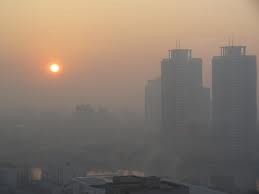Research on white women aged 70 years or older found that eating fish protects the brain from air pollution. Dr. Ka He from the Columbia University of New York published the new study on July 15, 2020 in the online issue of Neurology®, the medical journal of the American Academy of Neurology.
1,315 women who did not have dementia at the start of the study enrolled in it. Researchers measured the air pollution of the areas where the women lived. They also measured their omega-3 fatty acid blood levels. They found that women from polluted areas who ate the lowest amounts of fish and had the lowest amounts of omega-3 fatty acids in their blood, had the highest amount of brain shrinkage.
Methods of determining brain shrinkage, omega-3 fatty acids and pollution
The amount of brain shrinkage was determined with MRI scans of the brain. The amount of white brain matter was measured, particularly the size of the memory-sensitive hippocampus. Blood omega-3 fatty acid content was determined in red blood cells. Pollution was determined by the fine particulate matter in air pollution at the address where the patient lived. Every woman in the study received a diet questionnaire regarding fish consumption. From this information the researchers determined the average fish consumption per week. This included broiled and baked fish, non-fried shellfish, canned tuna, tuna casserole and tuna salad. Deep fried fish was not part of the list, because other studies showed that deep-frying damages omega-3 fatty acids.
More details regarding the study
The researchers adjusted the study according to age, smoking status, and other factors that could affect brain shrinkage. Women with the highest intake of omega-3 fatty acids had the highest volume of white matter in their brains as MRI scans showed. Specifically, the researchers noted the following findings:
- Women with the highest omega-3 fatty acid level had 410 cubic cm white matter
- Women with the lowest omega-3 fatty acid level had 403 cubic cm white matter
- Each quartile increase in air pollution caused shrinkage of white matter by 11.52 cubic cm in those women with low omega-3 fatty acid consumption
- In women with higher omega-3 fatty acid levels each quartile increase in air pollution caused shrinkage of white matter by only 0.12 cubic cm
- Women with the highest omega-3 fatty acid intake had the highest volume of the hippocampus
Comments by the lead author of the study
Dr. Ka He stated: “Our findings suggest that higher levels of omega-3 fatty acids in the blood from fish consumption may preserve brain volume as women age and possibly protect against the potential toxic effects of air pollution.” But Dr. Ka He cautioned: “It’s important to note that our study only found an association between brain volume and eating fish. It does not prove that eating fish preserves brain volume. And since separate studies have found some species of fish may contain environmental toxins, it’s important to talk to a doctor about what types of fish to eat before adding more fish to your diet.”
Limitations of study
The study was involving older white women. This means that the results cannot be generalized to Afro Americans, Hispanics or Asians. The researchers examined exposure to pollution only later in life, not in early life or midlife. Hopefully future studies will examine what happens with lifelong exposure to pollution.
How to limit mercury exposure when eating fish
Omega-3 fatty acids are abundantly present in fish. It has plaque-reducing properties and also reduces the risk for abnormal heart beats. Overall this means less cardiovascular disease. The American Heart Association recommends a 3.5 oz. serving of fatty fish (salmon, mackerel, lake trout, herring or sardines) twice per week.
Mercury and other pollutants
Pollution of the air, soil and rivers is causing accumulation of mercury and other heavy metals in ocean water.
This affects fish that live in the ocean. There is a pecking order of predators with the larger fish feeding on the smaller fish. The bigger the predator fish, the more mercury and other pollutants they accumulate. According to this link the safest seafood is wild salmon, pollock and oysters.
High mercury content of predator fish
Tuna is too high in mercury, so is swordfish, and shark is even worse. I only consume fish from freshwater lakes or rivers, as well as salmon, oysters and shrimp. This way I get the lowest exposure to mercury. Why is mercury bad for you? It is a neurotoxin. It can harm your brain, heart, kidneys, lungs and the immune system. Specific symptoms can include loss of peripheral vision and lack of coordination with balancing problems. There may be impairment of speech and hearing. The key is to avoid mercury exposure.
Smaller fish low in mercury
The first line of defense is to stick to the smaller fish. They are they prey of the large predator fish. The following fish/mussels belong into the low mercury group (alphabetical order): anchovies, catfish, clam, crab, crawfish, flounder, haddock, herring, mackerel, mullet, oyster, perch, pollock, salmon, sardines, scallops, shrimp, sole, squid, trout and whitefish.
Molecularly distilled omega-3 fatty acid supplements
You may want to supplement your omega-3 fatty acid intake by fish oil capsules. It is important that you choose the more expensive higher potency products. A molecular distillation process that removes mercury, PCB and other heavy metals creates these higher potency products. This way you only get the enriched omega-3 fatty acids in pure form. EPA and DHA in one capsule should be in the 900 mg to 1000 mg range, not less. I take 2 capsules twice per day as a daily supplement. This helps you to balance the omega-6 to omega-3 ratio, which cuts down any inflammatory process (from too many omega-6 fatty acids) in you.
Conclusion
A new study from the Columbia University of New York has shown that women older than 70 can preserve the white matter of their brains by consumption of fish. This included the hippocampus which is crucial for memory. The researchers measured the recent exposure of these women to pollution. They noted that the women who were exposed to the highest amounts of pollution had the best protection of the white matter of their brains by the highest consumption of omega-3 fatty acids from fish. Omega-3 fatty acids are also important to prevent heart attacks and strokes. Omega-6 fatty acids can cause inflammation, but when enough omega-3 fatty acids are part of the nutrition, the omega-6/omega-3 fatty acid ratio switches towards anti-inflammation and health.
How to consume omega-3 fatty acids safely
Omega-3 fatty acids are in fish and seafood. Unfortunately, mercury is contaminating these foods. But when you stick to the smaller fish and use molecularly distilled omega-3 supplements you can largely avoid this problem.
Parts of this text has been published before here.







